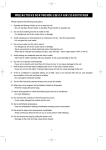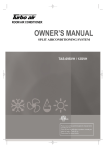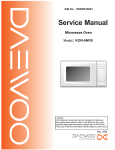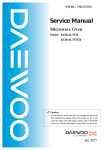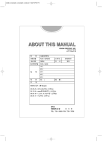Download Daewoo KOR-6NM51A Service manual
Transcript
S/M No. : R6N575S001 Service Manual Microwave Oven Model: KOR-6N575S ✔ Caution : In this Manual, some parts can be changed for improving, their performance without notice in the parts list. So, if you need the latest parts information, please refer to PPL(Parts Price List) in Service Information Center (http://svc.dwe.co.kr). July. 2006 PRECAUTIONS TO BE OBSERVED BEFORE AND DURING SERVICING TO AVOID POSSIBLE EXPOSURE TO EXCESSIVE MICROWAVE ENERGY (a) Do not operate or allow the oven to be operated with the door open. (b) Make the following safety checks on all ovens to be serviced before activating the magnetron or other microwave source, and make repairs as necessary: (1) Interlock operation, (2) Proper door closing, (3) Seal and sealing surfaces (arcing, wear, and other damage), (4) Damage to or loosening of hinges and latches, (5) Evidence of dropping or abuse. (c) Before turning on power to the microwave oven for any service test or inspection within the microwave generating compartments, check the magnetron, wave guide or transmission line, and cavity for proper alignment, integrity, and connections. (d) Any defective or misadjusted components in the interlock, monitor, door seal, and microwave generation and transmission systems shall be repaired, replaced, or adjusted by procedures described in this manual before the oven is released to the owner. (e) A microwave leakage check to verify compliance with the Federal performance standard should be performed on each oven prior to release to the owner. TABLE OF CONTENTS SAFETY AND PRECAUTIONS ...........................................................................................................................................2 1. FOR SAFE OPERATION ..................................................................................................................................2 2. FOR SAFE SERVICE PROCEDURES .............................................................................................................2 SPECIFICATIONS ...............................................................................................................................................................3 EXTERNAL VIEW ................................................................................................................................................................4 1. OUTER DIMENSION ....................................................................................................................................... 4 2. FEATURE DIAGRAM ........................................................................................................................................5 INSTALLATION ...................................................................................................................................................................6 OPERATIONS AND FUNCTIONS .......................................................................................................................................7 DISASSEMBLY AND ASSEMBLY......................................................................................................................................8 INTERLOCK MECHANISM AND ADJUSTMENT .............................................................................................................15 TROUBLESHOOTING GUIDE .........................................................................................................................................16 MEASUREMENT AND TEST ............................................................................................................................................18 1. MEASUREMENT OF THE MICROWAVE POWER OUTPUT ........................................................................18 2. MICROWAVE RADIATION TEST ...................................................................................................................19 3. COMPONENT TEST PROCEDURE ...............................................................................................................20 WIRING DIAGRAM ............................................................................................................................................................21 EXPLODED VIEW AND PARTS LIST...............................................................................................................................22 1. DOOR ASSEMBLY .........................................................................................................................................22 2. CONTROL PANEL ASSEMBLY ......................................................................................................................22 3. TOTAL ASSEMBLY.........................................................................................................................................22 1 SAFETY AND PRECAUTIONS 1. FOR SAFE OPERATION Damage that allows the microwave energy (that cooks or heats the food) to escape will result in poor cooking and may cause serious bodily injury to the operator. IF ANY OF THE FOLLOWING CONDITIONS EXIST, OPERATOR MUST NOT USE THE APPLIANCE. (Only a trained service personnel should make repairs.) (1) A broken door hinge. (2) A broken door viewing screen. (3) A broken front panel, oven cavity. (4) A loosened door lock. (5) A broken door lock. The door gasket plate and oven cavity surface should be kept clean. No grease, soil or spatter should be allowed to build up on these surfaces or inside the oven. DO NOT ATTEMPT TO OPERATE THIS APPLIANCE WITH THE DOOR OPEN. The microwave oven has concealed switches to make sure the power is turned off when the door is opened. Do not attempt to defeat them. DO NOT ATTEMPT TO SERVICE THIS APPLIANCE UNTIL YOU HAVE READ THIS SERVICE MANUAL. 2. FOR SAFE SERVICE PROCEDURES 1. If the oven is operative prior to servicing, a microwave emission check should be performed prior to servicing the oven. 2. If any certified oven unit is found to servicing, a microwave emission check should be performed prior to servicing the oven. (a) inform the manufacturer, importer or assembler, (b) repair the unit at no cost to the owner, (c) attempt to ascertain the cause of the excessive leakage, (d) tell the owner of the unit not to use the unit until the oven has been brought into compliance. 3. If the oven operates with the door open, the service person should tell the user not to operate the oven and contact the manufacturer and the dealer immediately. IMPORTANT The wire in this main lead coloured in accordance with the following code. Green-and-yellow : Earth Blue : Neutral Brown : Live As the colours of the wires in the main lead of this appliance may not correspond with the coloured markings identifying the terminals in your plug, proceed as follows. The wire which is coloured green-and-yellow must be connected to the terminal in the plug which is marked with the letter E , earth symbol or coloured green-and-yellow. The wire which is coloured blue must be connected to the terminal which is marked with the letter N or coloured black. The wire which is coloured brown must be connected to the terminal which is marked with the letter L or coloured red. NOTE This oven is designed for counter-top use only. 2 SPECIFICATIONS MODEL POWER SUPPLY KOR-6N575S 230V~50Hz, SINGLE PHASE WITH GROUNDING POWER CONSUMPTION MICROWAVE 1,200W MICROWAVE ENERGY OUTPUT 800W MICROWAVE FREQUENCY 2450MHz OUTSIDE DIMENSIONS(WXHXD) 465 x 279 x 360mm CAVITY DIMENSIONS(WXHXD) 290 x 220 x 306 mm NET WEIGHT APPROX. 11.4kg (25.2 Ibs.) TIMER 60 MIN. DUAL SPEED FUNCTION SELECTIONS MICROWAVE POWER SELECTIONS 7 LEVELS CAVITY VOLUME 0.7 Cu. Ft. * SPECIFICATIONS ARE SUBJECT TO CHANGE WITHOUT NOTICE. 3 EXTERNAL VIEW 1. OUTER DIMENSION 4 2. FEATURE DIAGRAM 3 1 5 9 10 2 4 7 8 6 1. Safety interlock system 2. Door viewing screen - Allows viewing of food. The screen is designed so that light can pass through, but not the microwave. 3. Door hook - When the door is closed, it will automatically shut off. If the door is opened while the oven is operating, the automatically shut off. 4. Oven cavity 5. Door seal - Door seal maintains the microwave energy within the oven cavity and prevents microwave leak-age. 6. Glass cooking tray - Made of special heat resistant glass. Food in a proper receptacle is placed on this tray for cooking. 7. Roller guide - This must always be used for cooking together with the glass cooking tray. 8. Coupler - This fits over the shaft in the center of the ovens cavity floor. This is to remain in the oven for all cooking. 9. Knob V.P.C - Used to select a microwave power level. 10. Knob timer - Used in setting cooking time for all func-tion. 5 INSTALLATION 1. Steady, flat location. This microwave oven should be set on a steady, flat surface. 2. Leave space behind and side. All air vents should be kept a clearance. If all vents are covered during operation, the oven may be overheated and, eventually, cause oven failure. 3. Away from radio, and TV sets Poor television reception and radio interference may result if the oven is located close to a TV, radio, antenna, or feeder and so on. 4. Away from heating appliances and water taps Keep the oven away from hot air, steam or splash when choosing a place to position it, or the insulation might be adversely affected and breakdowns occur. 5. Power supply Check your local power source. This microwave oven requires a current of approximately 12 amperes, 230 Volts, 50 Hz. Power supply cord is about 0.8 meters long. The voltage used must be the same as specified on this oven. Using a higher voltage may result in a fire or other accident causing oven damage. Using low voltage will cause slow cooking. We are not responsible for damage resulting from use of this oven with a voltage of ampere fuse other than those specified. This appliance is supplied with cable of special type, which, if damaged, must be repaired with cable of same type. Such a cable can be purchased from DAEWOO and must be installed by a qualified person. 6. Examine the oven after unpacking for any damage such as: A misaligned door, broken door or a dent in cavity. If any of the above are visible, DO NOT INSTALL, and notify dealer immediately. 7. Do not operate the oven if it is colder than room temperature (This may occur during delivery in cold weather.) Allow the oven to become room temperature before operating. EARTHING INSTRUCTIONS This appliance must be earthed. In the event of an electrical short circuit, earthing reduces the risk of the electric shock by providing an escape wire for the electric current. This appliance is equipped with a cord having a earthing plug. The plug must be plugged into an outlet that is properly installed and earthed. WARNING Improper use of the earthing plug can result in a risk of electric shock. Consult a qualified electrician or serviceman if the earthing instructions are not completely understood, or if doubt exists as to whether the appliance is properly earthed, and either : If it is necessary to use an extension cord, use only a 3-wire extension cord that has a 3-blade earthing plut, and a 3-slot receptacle that will accept the plug on the appliance. The marked rating of the extension cord should be equal to or greater than the electrical rating of the appliance, or Do not use an extension cord. 6 OPERATIONS AND FUNCTIONS 1. Connect the main lead to an electrical outlet. 2. After placing the food in a suitable container, open the oven door and put it on the glass tray. The glass tray must always be in place during cooking. 3. Close the door securely. NOTE 1. When setting timer for less than 2 minutes, tum the timer past 2 minutes and then return to the correct timer setting. 4. Choose cooking power level by setting V.P.C knob to the desired position. Refer to cookbook for recommended power levels. 5. Determine cooking time. Consult cookbook for recipe timing. Oven light turns on and cooling fan starts to operate. Microwave cooking starts. 6. You may open the door while the oven is operating. As soon as the door is opened, the safety mechanisms stop the generation of microwave power and the operation of cooking timer. If you wish to change the time during cooking, simply adjust the timer to the desired time. 7. When the timer reaches zero, a bell will ring and the unit will turn off. Oven light turns off. If additional cooking time is needed and the door is closed, the oven will automatically start when the timer is reset. 2. Various clicking noises may be heard when turning V.P.C knob. This is normal and does not affect the operation of your microwave oven. Make sure the oven is properly installed and plugged into the electrical outlet. Variable power cooking ON and OFF cycle time of mechanical V.P.C switch is 30 seconds. When the V.P.C knob is set to the desired position and timer knob to the desired position, the V.P.C switch has a cycle (ON/OFF time(sec.)) listed below. Variable power setting Approximate Percentage Power level Symbol (KOR-63570S) of Power HIGH MAX 100% MED HIGH 700W 88% MEDIUM 580W 73% LOW STAGE 470W 59% DEFROST 17% HEAT 26% GENTLE HEATING 18% 7 DISASSEMBLY AND ASSEMBLY Cautions to be observed when troubleshooting. Unlike many other appliances, the microwave oven is high-voltage, high-current equipment. It is completely safe during normal operation. However, carelessness in servicing the oven can result in an electric shock or possible danger from a short circuit. You are asked to observe the following precautions carefully. 1. Always remove the power plug from the outlet before servicing. 2. Use an insulated screwdriver and ware rubber gloves when servicing the high voltage side. 3. Discharge the high voltage capacitor before touching any oven components or wiring. (1) Check the grounding. Do not operate on a two-wire extension cord. The microwave oven is designed to be used while earthed. It is imperative, therefore, to make sure it is earthed properly before beginning repair work. (2) Warning about the electric charge in the high voltage capacitor. For about 30 seconds after the operation stopped and electric charge remains in the high voltage capacitor. When replacing or checking parts, short between oven chassis and the negative high terminal of the high voltage capacitor by using a properly insulated screwdriver to discharge. 4. When the 12A fuse is blown out due to the operation of the monitor switch; replace primary interlock switch, secondary interlock switch and interlock monitor switch. 5. After repair or replacement of parts, make sure that the screws are properly tightened, and all electrical connections are tightened. 6. Do not operate without cabinet. SHORT CAUTION : Service personnel should remove their watches whenever working close to or replacing the magnetron. WARNING : When servicing the appliance, need a care of touching or replacing high potential parts because of electrical shock or exposing microwave. These parts are as follows - HV Transformer, Magnetron, HV Capacitor, HV Diode, HV fuse. 8 1. To remove cabinet 1) Remove three screws on cabinet back. 2) Pull the cabinet backward. 2. To remove door assembly 1) Remove the screw which secure the stopper hinge top. 2) Remove the door assembly from top plate of cavity. 3) Reverse the above for reassembly. NOTE : After replacing the door assembly, perform a check of correct alignment with the hinge and cavity front plate. 9 3. To remove door parts. REF NO. A01 A02 A03 A04 A05 A06 A07 A08 A09 A10 A11 A12 A13 A14 A15 PART CODE 3512203850 3517005620 3515204100 3511706120 3517002800 3512300200 3513100730 3515101310 7122401611 3512603300 3512603400 3511601500 3511604610 3511604600 3516003940 PART NAME FRAME DOOR BARRIER-SCREEN*O STOPPER HINGE*T AS DOOR PAINTING AS BARRIER-SCREEN*I GASKET DOOR HOOK SPRING HOOK SCREW TAPPING HANDLE DOOR *U HANDLE DOOR *T DECORATOR LOGO DECORATOR DOOR*U DECORATOR DOOR*T SPECIAL DOUBLE TAPE DESCRIPTION ABS XR-401, H-2938 TEMP GLASS T3.2 KOR-63150S KOR-634R0S PE 0.1T PP POM BLACK HSW-3 T2SN TRS 4X16 MFZN ABS XR-401, H-2938 STS T0.6 AL T1.5 STS T0.6 STS T0.6 SI-161 T0.15 27MM 10 Q’TY 1 1 1 1 1 1 1 1 2 1 1 1 1 1 1 REMARK 4. Method to reduce the gap between the door seal and the oven front surface. (1) To reduce gap located on part ‘A’ • Loosen the screw on stopper hinge top, and then push the door to contact the door seal to oven front surface. • Tighten a screw. (2) To reduce gap located on part ‘B’ • Loosen two screws on stopper hinge under, and then push the door to contact the door seal to oven front surface. • Tighten two screws. NOTE : A small gap may be acceptable if the microwave leakage does not exceed 4mW/cm2. 11 5. To remove control panel parts. REF NO. PART CODE PART NAME DESCRIPTION Q'TY B01 3513405460 KNOB VPC ABS XR-401, H-2938 1 B02 3513405460 KNOB TIMER ABS XR-401, H-2938 1 B03 3511603930 DECORATOR C-PANEL STS T0.6 1 B04 3516003950 SPECIAL DOUBLE TAPE SI-161 T0.15 1 B05 3516719070 CONTROL PANEL ABS XR-401, H-2938 1 B06 3515101600 SPRING FLAT SUS 301 T0.5 1 B07 7122401211 SCREW TAPPING T2S TRS 4*12 MFZN 1 B08 3518205100 TIMER KN60MKD 12E-P 1 B09 7122401211 SCREW TAPPING T2S TRS 4*12 MFZN 2 B10 3517400400 COUPLER TIMER POM 1 B11 3517400510 COUPLER VPC KNOB POM 1 REMARK 1) Remove the screw which secure the control panel, push up two snap fits and draw forward the control panel assembly. 2) Remove two screws which secure the timer assembly. 3) Remove the timer assembly. 4) Pull out the timer knob from the timer. 5) Pull out the timer coupler from the timer. 6) Remove the screw which secure the V.P.C coupler. 7) Pull out the V.P.C coupler, V.P.C knob and flat spring from the control panel. 8) Reverse the above steps for reassembly. 12 6. To remove high voltage capacitor. 1) Remove the screw which secure the grounding ring terminal of the H.V. diode and the capacitor holder. 2) Remove the H.V. diode from the capacitor holder. 3) Reverse the above steps for reassembly. High voltage circuit wiring 7. To remove magnetron. 1) Remove the screw which secure the magnetron. 2) Remove the magnetron. 3) Reverse the above steps for reassembly. NOTE : Never install the magnetron without the metallic gasket plate which is packed with each magnetron to prevent microwave leakage. Whenever repair work is carried out on magnetron, check the microwave leakage. It shall not exceed 4mW/cm2 for a fully assembled oven with door normally closed. Magnetron antenna Metallic gasket plate Cooling fin Filament terminal <MAGNETRON> 13 8. To remove wind guide assembly. 1) Remove the screw for earthing. 2) Remove the noise filter from the wind guide. 3) Remove the screw which secure the wind guide assembly. 4) Draw forward the wind guide assembly. 5) Pull the fan from the motor shaft. 6) Remove two screws which secure the motor shaded pole. 7) Remove the motor shaded pole. 8) Reverse the above steps for reassembly. 9. To remove H.V.transformer. 1) Remove four screws holding the H.V.transformer. 2) Remove the H.V.transformer. 3) Reverse the above steps for reassembly. 14 INTERLOCK MECHANISM AND ADJUSTMENT The door lock mechanism is a device which has been specially designed to completely eliminate microwave radiation when the door is opened during operation, and thus to perfectly prevent the danger resulting from the leakage of microwave. (1) Primary interlock switch When the door is closed, the hook locks the oven door. If the door is not closed properly, the oven will not operate. When the door is closed, the hook pushes the button of the microswitch. Then the button of the primary interlock switch bring it under NO condition. (2) Secondary interlock switch and interlock monitor switch When the door is closed, the hook pushes the lock lever downward. The lock lever presses the button of the interlock monitor switch to bring it under NO condition and presses the button of the secondary interlock switch to bring it under NO condition. ADJUSTMENT : Interlock monitor switch When the door is closed, the interlock monitor switch should be changed (NO condition) before other switches are closed. When the door is opened, the interlock monitor switch should be changed (NC condition) after other switches are opened. (3) Adjustment steps a) Loosen the mounting screw. b) Adjust interlock switch assembly position. c) Make sure that lock lever moves smoothly after adjustment is completed. d) Tighten completely a mounting screw. NOTE : Microwave emission test should be performed after adjusting interlock mechanism. If the microwave emission exceed 4mW/cm2, readjust interlock mechanism. 15 TROUBLESHOOTING GUIDE Following the procedure below to check if the oven is defective or not. 1. Check grounding before trouble checking. 2. Be careful of the high voltage circuit. 3. Discharge the high voltage capacitor. 4. When checking the continuity of the switches, fuse or high voltage transformer, disconnect one lead wire from these parts and check continuity with the AC plug removed. To do otherwise may result in a false reading or damage to your meter. (TROUBLE 1) Door shut, timer set, but no cooking takes place. Does the fan motor work when you shut the door and turn the timer? YES (Refer to next page) NO Does the fuse blow? YES Check continuity of interlock monitor switch with door shut. NO Continuity Replace primary, secondary interlock switch and interlock monitor switch. NO Replace primary, secondary interlock switch and interlock monitor switch. Normal Replace high voltage capacitor and high voltage diode. NO Continuity Replace fuse and check continuity of both interlock switch s contact and monitor switch s contact with door partially open until monitor switch contact. Both continuity Disconnect one side of the lead wire connected from transformer to the high voltage capacitor, and operate oven. Fuse again If outlet has proper voltage, check continuity of power supply cord. Replace high voltage transformer NO Continuity Replace power supply cord. 16 Does the fan motor work when you shut the door and turn the timer? YES Does the oven lamp light? Does the turntable turn? NO Replace or repair oven lamp, turntable motor. YES Normal reading should be approx. 0 If microwave do not oscillate, check continuity of filament of magnetron. NO Continuity Poor continuity Check continuity No Continuity filament tap (3.3V) of high voltage transformer. Replace high voltage transformer Continuity Continuity in the reverse Check continuity direction. filament tap (3.3V) of high voltage transformer. Replace high voltage diode Continuity Replace magnetron Meter with 600V or higher voltage Meger should be used to check the normal direction resistance of the diode Check the isolation of filament winding of high voltage transformer. NO Continuity Replace high voltage transformer. Good Replace magnetron 17 MEASUREMENT AND TEST 1. MEASUREMENT OF THE MICROWAVE POWER OUTPUT Microwave output power can be checked by indirectly measuring the temperature rise of a certain amount of water exposed to the microwave as directed below. PROCEDURE 1. Microwave power output measurement is made with the microwave oven supplied at rated voltage and operated at its maximum microwave power setting with a load of 1000 5cc of potable water. 2. The water is contained in a cylindrical borosilicate glass vessel having a maximum material thickness of 3 mm and an outside diameter of approximately 190 mm. 3. The oven and the empty vessel are at ambient temperature prior to the start of the test. The initial temperature of the water is 10 2 C (50 3.6 F) It is measured immediately before the water is added to the vessel. After addition of the water to the vessel, the load is immediately placed on the center of the shelf, which is in the lowest normal position. 4. Microwave power is switched on. 5. Heating time should be exactly A seconds. (Refer to table as following) Heating time is measured while the microwave generator is operating at full power. The filament heat-up time for magnetron is not included. 6. The initial and final temperature of water is selected so that the maximum difference between the ambient and final water temperature is 5K. 7. The microwave power output P in watts is calculated from the following formula : P=4187 X T/t T is difference between initial and ending temperature. t is the heating time. The power measured should be B (Refer to SPECIFICATIONS)W 10.0%. CAUTION : 1. Water load should be measured exactly to 1 liters. 2. Input power voltage should be exactly specified voltage(Refer to SPECIFICATIONS). 3. Ambient temperature should be 20 2 C(68 3.6 F) Heating time for power output: A(second) 70 64 60 56 52 49 47 44 42 40 38 B(W) 600 650 700 750 800 850 900 950 1000 1050 1100 18 2. MICROWAVE RADIATION TEST WARNING : Make sure to check the microwave leakage before and after repair of adjustment. Always start measuring of an unknown field to assure safety for operating personnel from microwave energy. Do not place your hands into any suspected microwave radiation field unless the safe density level is known. Care should be taken not to place the eyes in direct line with the source of microwave energy. Slowly approach the unit under test until the radiometer reads an appreciable microwave leakage from the unit under the test. PROCEDURES 1. Prepare Microwave Energy Survey Meter, 600cc glass beaker, and glass thermometer 100 C(212 F). 2. Pour 275cc 15cc of tap water initially at 20 5 C(68 9 F) in the 600cc glass beaker with an inside diameter of approx. 95mm(3.5in.). 3. Place it at the center of the tray and set it in a cavity. 4. Close the door and operate the oven. 5. Measure the leakage by using Microwave Energy Survey Meter with dual ranges, set to 2450MHz. 1) Measured radiation leakage must not exceed the value prescribed below. Leakage for a fully assembled oven with door normally closed must be less than 4mW/cm2. 2) When measuring the leakage, always use the 5cm(2in.) space cone with probe. Hold the probe perpendicular to the cabinet and door. Place the space cone of the probe on the door, cabinet, door seem, door viewing screen, the exhaust air vents and the suction air vents. 3) Measuring should be in a counter-clockwise direction at a rate of 1 in./sec. If the leakage of the cabinet door seem is unknown, move the probe more slowly. 4) When measuring near a corner of the door, keep the probe perpendicular to the areas making sure the probe end at the base of the cone does not get closer than 2 in. from any metal. If it does not, erroneous reading may result. 19 3. COMPONENT TEST PROCEDURE High voltage is present at the high voltage terminal of the high voltage transformer during any cooking cycle. It is neither necessary nor advisable to attempt measurement of the high voltage. Before touching any oven components or wiring, always unplug the oven from its power source and discharge the capacitor. 1. High voltage transformer (1) Remove connections from the transformer terminals and check continuity. (2) Normal readings should be as follows(at 20 C): Secondary winding.....................Approx. 170 10% Filament winding....................................Approx. 0 Primary winding .........................Approx. 2.5 10% 2. High voltage capacitor (1) Check continuity of capacitor with meter on the highest OHM scale. (2) A normal capacitor will show continuity for a short time, and then indicate 10M once the capacitor is charged. (3) A shorted capacitor will show continuous continuity. (4) An open capacitor will show constant 10M . (5) Resistance between each terminal and chassis should be infinite. 3. High voltage diode (1) Isolate the diode from the circuit by disconnecting the leads. (2) With the ohmmeter set on the highest resistance scale measure the resistance across the diode terminals. Reverse the meter leads and again observe the resistance reading. Meter with 600V or higher voltage Meger should be used to check the front-back resistance of the diode, otherwise an infinite resistance may be read in both directions. A normal diode s resistance will be infinite in one direction and several hundred K in the other direction. 4. Magnetron For complete magnetron diagnosis, refer to Measurement of the Microwave Power Output . Continuity checks can only indicate and open filament or a shorted magnetron. To diagnose for an open filament or a shorted magnetron. (1) Isolate magnetron from the circuit by disconnecting the leads. (2) A continuity check across magnetron filament terminals should indicate 0.1 or less. (3) A continuity check between each filament terminal and magnetron case should read open. 5. Fuse If the fuse in the primary and monitor switch circuit is blown when the door is opened, check the primary and monitor switch before replacing the blown fuse. In case the fuse is blown by an improper switch operation, replace the defective switch and fuse at the same time. Replace just the fuse if the switches operate normally. 20 WIRING DIAGRAM 21 EXPLODED VIEW AND PARTS LIST 1. DOOR ASSEMBLY Refer to Disassembly and assembly. 2. CONTROL PANEL ASSEMBLY Refer to Disassembly and assembly. 3. TOTAL ASSEMBLY 22 NAME PART CODE PART NAME DESCRIPTION Q'TY A00 3511712150 DOOR AS KOR-63570S 1 B00 3516723710 CONTROL-PANEL AS KOR-63570S 1 F01 3510808400 CABINET AS KOR-6NM51A 1 F02 7112401011 SCREW TAPPING T1 TRS 4*10 MFZN 3 F03 3516117400 CAVITY AS KOR-6NM51A 1 F04 7122401211 SCREW TAPPING T2S TRS 4X12 MFZN 1 F05 7122401211 SCREW TAPPING T2S TRS 4X12 MFZN 1 F06 7112401011 SCREW TAPPING T1 TRS 4*10 MFZN 2 F07 35113AEQ0D CORD POWER AS 3X0.75 70X70 100-RTML 1 F08 7112401011 SCREW TAPPING T1 TRS 4*10 MFZN 1 F09 7121300611 SCREW TAPPING T2S PAN 3X6 MFZN 1 F10 3518917200 THERMOSTAT OFF:85 ON:75 H #187 1 F11 3518607600 NOISE-FILTER DWLF-M12 A 250V 10A 1 F12 7121402511 SCREW TAPPING T2S PAN 4X25 MFZN 2 F13 3963512310 MOTOR SHADED POLE 230V 20W MW10CA-M02 1 F14 3512517000 GUIDE WIND PP 1 F15 3511800300 FAN PP+30%GLASS 1 F16 3518003700 MAGNETRON 2M218JFL 6CF 1 F17 3516004000 SPECIAL SCREW T2 BOLT FLANGE 5X12 DACRO 1 F18 7122400811 SCREW TAPPING T2S TRS 4*8 MFZN 1 F19 3513003200 HOLDER HV CAPACITOR SECC T0.6 1 F20 3518302200 CAPACITOR HV 2100VAC 0.98UF #187 1 F21 3518400900 DIODE HV AS HVR-1X-30B #187 1 F22 3518701100 FUSE HV 5KV 0.55A HV-41A55-02 1 F23 3518119880 TRANS HV R1S580(EA00) 1 F24 3516003700 SPECIAL SCREW TT3 HEX 4X8 FLG MFZN 4 F25 3510316000 BASE SBHG T0.7 1 F26 7112401011 SCREW TAPPING T1 TRS 4*10 MFZN 5 F27 3512100900 FOOT PP DASF-130 2 F28 7272400811 SCREW TAPTITE TT3 TRS 4X8 MFZN 1 F29 3515201101 STOPPER HINGE *U SCP-1 T2.5 1 F30 3512781410 HARNESS MAIN KOR-6NM53S 1 F31 7122401211 SCREW TAPPING T2S TRS 4X12 MFZN 1 F32 3518570400 SWITCH S/A RELAY DWSR-1 1 F33 4415A17352 SW MICRO VP-533A-OF SPNO #187 200G 1 F34 4415A66910 SW MICRO VP-531A-OF/SZM-V16-FA-61 1 F35 4415A17352 SW MICRO VP-533A-OF SPNO #187 200G 1 F36 3513702610 LEVER LOCK POM 1 F37 3513811710 LOCK POM BLACK 1 F38 3513601600 LAMP BL 240V 25W T25 C7A H187 1 F39 7112401011 SCREW TAPPING T1 TRS 4*10 MFZN 1 F40 3966031600 MOTOR SYNCRO 220/240V 50/60HZ ST-16 MN73MQAD A 1 F41 7272400811 SCREW TAPTITE TT3 TRS 4X8 MFZN 1 F42 3511406220 COVER WAVE GUIDE HEATPROOF PP 1 F43 3517400620 COUPLER XAREC 1 F44 3514700710 ROLLER TEFLON 3 F45 3512517300 GUIDE ROLLER PP 5113MF6 A353B 1 F46 3517203610 TRAY BORO-SI GLASS(NEG) 1 23 DAEWOO ELECTRONICS CORP. 686, AHYEON-DONG MAPO-GU SEOUL, KOREA C.P.O. BOX 8003 SEOUL, KOREA TELEX: DWELEC K28177-8 CABLE: “DAEWOOELEC” S/M NO. : PRINTED DATE: July. 2006 ABOUT THIS MANUAL VISION CREATIVE, INC. 서울 종로구 통의동 6 번지 이룸빌딩 4 층 담 당 TEL 심송섭과장님 MODEL KOR-6N575S(S/M) 접수 06.7.11(신규)-총 25page 일 정 제 판 규 격 1차 6차 2차 7차 3차 8차 4차 9차 5차 10차 인쇄 MEMO 06.7.11-표지앞,뒤,3,4,5,10,11,12,19,22,23_(신규11p) 06.7.12-3,7,22,23_수정 연락처 VISION 담 당 이지혜 TEL : 02)730-0660 FAX : 02)730-3788 -매뉴얼의 첫장에 이 서식을 작성해주세요-



























